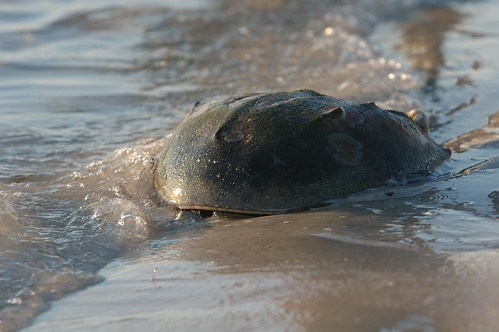Horseshoe Crabs Return to Maryland Shores for Spawning
Public Can Help Document Spawning Sites
 The horseshoe crab — Limulus polyphemus — is returning to Maryland’s coastal shores this month for one of the world’s oldest and largest wildlife migrations.
The horseshoe crab — Limulus polyphemus — is returning to Maryland’s coastal shores this month for one of the world’s oldest and largest wildlife migrations.
Each spring adult horseshoe crabs migrate into the coastal bays from offshore overwintering areas to spawn on sandy beaches and, to a lesser extent, subtidal habitats.
Spawning occurs on the spring high tides from May through early August, peaking on the day of or after each full and new moon of these months. The annual peak in spawning activity generally occurs around the full and new moon in mid-June.
During this time, biologists from the Maryland Department of Natural Resources are encouraging the public to report any spawning activity sightings to the Horseshoe Crab Volunteer Angler Survey. Information provided helps the department monitor horseshoe crab numbers and contributes to scientific research.
For the past 350 million years, these prehistoric arthropods have come from the depths of the Atlantic Ocean each year to lay their eggs on Maryland’s shores.
On average, one female horseshoe crab will deposit roughly 20,000 eggs. The eggs are buried approximately six inches beneath the sand at the water’s edge and hatch in two to four weeks.
Birds preying upon the eggs are a natural part of this cycle. Horseshoe crab eggs are essential food for migrating shorebirds to fuel up on their own migration from Tierra del Fuego in Argentina to Northern Canada to nest.
Despite a horseshoe crab’s armor and menacing tail, they are gentle creatures that do not bite or sting, and can only survive outside of water for a short amount of time.
Anyone who plans to observe any part of the migration should remember that although Maryland beaches are open, guidance on social distancing must be followed, and gatherings of 10 or more people are prohibited.
